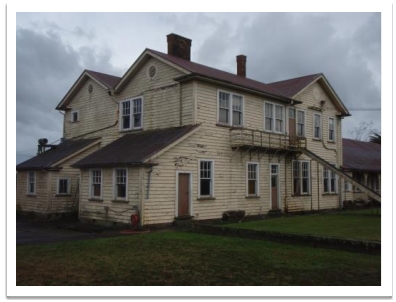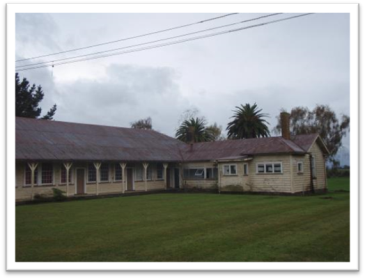HH-24: Hodderville Homestead, Boys’ Home And Training Farm
(Front Part Of Main T-Building Only)

Date of Photograph: 27/05/2008
Location and Zoning Information | |
Address |
978 Old Taupo Rd |
Current Owner |
Hodderville Farms Ltd |
Legal Description |
Lots 9 DPS 60062 |
Zoning |
General Rural Zone |
Valuation Number |
0541306800 |
Google Maps Link |
|
Architecture | |
Date of Construction |
Land purchased by Salvation Army in 1917 and opened in 1920. |
Materials |
Main building approximately T shaped in plan. Central entry porch is classical revival and features a hipped gable roof supported by ionic columns. The entry features central double doors and side doors at each end of the porch. The doors have six lights in the top half and transom lights. The main one story building was originally connected to a two storey building at the point of the T. The two-storey portion was demolished in August 2012. The one story part has gabled roof with parallel gable roofed wings. The gable ends all feature returns, and near the apex of the wall have circular vents with horizontal wooden louvres. The entire main building complex is clad with wooden weatherboards and features double hung windows with six over one lights. Distinctive detailing repeated in other buildings in the complex. |
Architecture/Engineer/Builder |
Unknown |
Condition |
Currently vacant except Supervisor's house. Supervisor's house used as a residence. Front of properties being maintained. |
Original Site Recommendation |
Public consultation, confirmed by Heritage Advisor, HNZPT. |
Current Use |
Supervisor’s house in use. Other buildings vacant. |
Statement of Significance | |
(1 Historical) - Aspect of history, 1920's through 1950's social responsibility movement, English Farm Cadet programme, and history of the Salvation Army in New Zealand. Reflects important or representative aspects of South Waikato. Home was associated with events, persons, or ideas of importance in South Waikato history, Salvation Army's commitment to social service and community needs as provided by a farm home for orphaned or disadvantaged boys and later as a substance abuse treatment centre. (3 Community Association) - has important community association and public esteem, played a central role in Hodderville and the South Waikato as a social institution (orphanage and farm training facility); associated with the lives of many New Zealand men who passed through its doors over a 60 year period. (6 Educational) - has the potential to educate the public about the history of South Waikato. The Boys' Home was part of NZ social history and could be interpreted and used for discussing both social history and social responsibility with students. (10 Architectural) - consistient style and detailing used throughout complex. (11 Context) - Home part of a complex or landscape. Visual aspects to consider that relate to history, landscape, frontage sweeping drive and front lawn. (12 Rarity) - is a rare type of historic place, only orphanage in South Waikato District (historical aspect, no longer used as an orphanage). (13 Integrity) - good level of integrity. District Plan RulesDemolition - DIS. Protection focus - 1, 3, 6, 10, 11 and 12. Mitigate the effects of demolition by requiring applicant to provide a Historic Building Documentation (HBD) which should include the buildings' history, photographic documentation, and measurements of the building prior to removal. Emphasis should be placed on recording how the building operated as an orphanage and recording any internal or external features that relate to use and the way of life of orphans at the facility. Alterations necessary for the primary purpose of improving structural performance, fire safety or physical access – CON -Refer to HH-R2. Other Additions/Alterations - DIS. Protection focus - 1, 6, 10 and 12. Effects can be mitigated/remedied through; a) HBD - See mitigating the effects of demolition. b) Design rules: 1.The overall visual character/shape of the front part of the original building should be identifiable. The addition should not dominate the existing building. 2. New work should be restricted to the rear of the building and not be evident from the road frontage. 3. The following special elements that are associated with the rarity or architectural uniqueness or craftsmanship of the structure should be retained: Elements of the structure that should be retained are those elements associated with its historic use as a rare type of structure, i.e.: front façade, lawn, driveway through lawn to building, exterior walls, openings, chimney, and any other special elements identified in the HBD. Repair of Structure - PER. Refer to HH-R1. Protection focus - 1, 10 and 11. Re-use/Change of Use - PER. Refer to HH-R1. Protection focus - 1, 3, 6 and 12. Internal Changes - DIS - buildings is remarkably intact - can still be adapted but effects need active management and recording. Relocation - DIS. Protection focus - 1, 11 and 12. Disturbance of the site surface/earthworks - Note: Any place that was associated with human activity prior to 1900 and is able to provide evidence relating to the history of New Zealand is an 'archaeological site' (refer to definition of 'archaeological site' in Section 2 of the Heritage New Zealand Pouhere Taonga Act 2014). All archaeological sites are protected under the Heritage New Zealand Pouhere Taonga Act 2014 and approval from Heritage New Zealand must be obtained prior to destroying, damaging or modifying any site. Accordingly, where this site on which a building is located is an 'archaeological site' and the building is to be repaired, added to, relocated or demolished and this involves disturbance to the surface and/or subsurface of the site, approval from Heritage New Zealand is required. Surrounds - Protection extends to cover the front yard and the following: -
DIS consent required for tree removal. (normal gardening, pruning and maintenance of tree health is PER). The location and shape of the original driveway should continue to be obvious. | |
History | |
The Boys Home included a main building (orphan accommodation/dining room, kitchen, laundry), woodshed, staff quarters, a chapel, farm buildings (milking shed and stables), vegetable garden, a well, a football field, gym and swimming pool (located across road). Supervisor's house detached from main building. A Salvation Army home for orphans and boys whose family could not afford to keep them. Also accommodated British Farm Cadets who were training to work in New Zealand. The facility was operated from 1920 to 1989 by the Salvation Army. Toward the end of the homes' operation it was used as a rehabilitation centre for substance abusers. Only orphanage in the South Waikato District. (A. Simmons 09/10/00). Had approx. 80 boys at peak. They attended Hodderville School and worked their way up from kitchen to laundry to farm. At age 12 the boys worked on the Army's 980ha farm. The brighter boys went to Putāruru College. Many of the boys that worked on the Army farm moved to local farm employment once they were mature. | |
Additional Photographs

